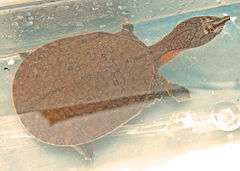New Guinea giant softshell turtle
| New Guinea giant softshell turtle | |
|---|---|
| Scientific classification | |
| Kingdom: | Animalia |
| Phylum: | Chordata |
| Subphylum: | Vertebrata |
| Class: | Reptilia |
| Order: | Testudines |
| Family: | Trionychidae |
| Genus: | Pelochelys |
| Species: | P. bibroni |
| Binomial name | |
| Pelochelys bibroni (Owen, 1853) | |
| Synonyms[1] | |
| |
The New Guinea giant softshell turtle (Pelochelys bibroni) is a species of softshell turtle in the Trionychidae family.[2] It is referred to by the Suki people as kiya eise, a reference to its flexible shell. In the Arammba language, it is called sokrere, meaning "earthquake".[3] It is sometimes hunted by local villages for its meat and/or eggs, leading to some cases of chelonitoxism.[4]
P. bibroni prefers lowland rivers and estuaries, but adjusts well to the saline environments of deltas and large estuaries. Its diet is primarily carnivorous, consuming mostly fish, crabs, mollusks, and occasionally some vegetation. Its hunting strategy is not overly aggressive, but primarily being an ambush predator, it spends most of its time at the bottom of its chosen river bed, waiting for prey to wander by.[5]
Nesting usually occurs in September, often on the same beaches as the pig-nosed turtle. The 22-45 eggs in a clutch are often found in the nests of crocodiles. This is possibly a strategy to avoid nest predation.[5]
Etymology
The specific name, bibroni, is in honor of French herpetologist Gabriel Bibron.[6]
Geographic range
P. bibroni ranges from southern China to West Papua (Indonesia) and Papua New Guinea, but may also be found in Australia and the Philippines.[7] It has recently gone extinct in the Mekong and Chao Phraya River basins.[8]
Description
P. bibroni is the second-largest species of freshwater turtle, surpassed in size only by Pelochelys cantorii. Members of the species can reach up to a meter in length, and 120 kg in weight.[5]
It has a soft, subdermal carapace with a slightly flexible posterior region.[9] Its neck is completely retractable, as are all four of its limbs. Its head is broad, with its nostrils at the end of a proboscis. Its digits are webbed, with eight digits on its fore limbs and five on its hind limbs. Its tail is very short.
Though the species is known to use deep, freshwater rivers as its primary habitat, the species may show some saltwater tolerance due to its wide geographical range.[7]
Possible chelonitoxism
P. bibroni is believed to be a species of marine turtle that, upon consumption during certain seasons of the year, can lead to the phenomenon of chelonitoxism in a person. This may be due to certain phases in the turtle's diet.[10]
Threatened status
P. Bibroni has a natural predator in the saltwater crocodile, but its current status as a threatened species stems from human activity. Locals often hunt the animal for its meat and eggs, and tribal masks can be crafted from its carapace. No commercial hunting is present, however.[5]
References
- ↑ Fritz, Uwe; Havaš, Peter (2007). "Checklist of Chelonians of the World". Vertebrate Zoology. 57 (2): 317. ISSN 1864-5755. Archived from the original (PDF) on 2010-12-17. Retrieved 29 May 2012.
- ↑ Turtles of the World: Annotated Checklist of Taxonomy and Synonymy, December 2010.
- ↑ Georges, Arthur, Fiorenzo Guarino, and Biatus Bito. "Freshwater turtles of the TransFly region of Papua New Guinea–notes on diversity, distribution, reproduction, harvest and trade." Wildlife Research 33.5 (2006): 373-384.
- ↑ Georges, A., Alacs, E., Pauza, M., Kinginapi, F., Ona, A., and Eisemberg, C. (2008) Freshwater turtles of the Kikori Drainage, Papua New Guinea, with special reference to the pig-nosed turtle, Carettochelys insculpta. Wildlife Research 35, 700–711.
- 1 2 3 4 Bonin, Franck, Bernard Devaux, and Alain Dupré. Turtles of the World. JHU Press, 2006.
- ↑ Beolens B, Watkins M, Grayson M. 2011. The Eponym Dictionary of Reptiles. Baltimore: Johns Hopkins University Press. xiii + 296 pp. ISBN 978-1-4214-0135-5. (Pelochelys bibroni, p. 25).
- 1 2 Nair, P. N., and M. Badrudeen. "On the occurrence of the soft-shelled turtle, Pelochelys bibroni (Owen) in marine environment." Indian Journal of Fisheries 22.1&2 (1975): 270-274.
- ↑ Thirakhupt, Kumthorn, and Peter Paul van Dijk. "Species diversity and conservation of turtles in western Thailand." Natural History Bulletin of the Siam Society 42 (1994): 207-259.
- ↑ Rhodin, Anders GJ, Sylvia Spring, and Peter CH Pritchard. "Glossary of turtle vernacular names used in the New Guinea region." The Journal of the Polynesian Society (1980): 105-117.
- ↑ Silas, E. G., and A. Bastian Fernando. "Turtle poisoning." CMFRI Bulletin 35 (1984): 62-75.
Further reading
- Owen R. 1853. Descriptive Catalogue of the Osteological Series Contained in the Museum of the Royal College of Surgeons of England. Volume I. Pisces, Reptilia, Aves, Marsupalia. London: Royal College of Surgeons. (Taylor and Francis, printers). xlv + 350 pp. ("Trionyx (Gymnopus) Bibroni", p. 185).
External links
- Asian Turtle Trade Working Group. 2000. Pelochelys bibroni. 2006 IUCN Red List of Threatened Species. Downloaded on 9 July 2007.

